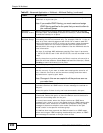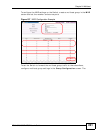
Chapter 24 Multicast
XGS-4526/4528F/4728F User’s Guide
235
24.6 MVR Overview
Multicast VLAN Registration (MVR) is designed for applications (such as Media-on-
Demand (MoD)) that use multicast traffic across an Ethernet ring-based service
provider network.
MVR allows one single multicast VLAN to be shared among different subscriber
VLANs on the network. While isolated in different subscriber VLANs, connected
devices can subscribe to and unsubscribe from the multicast stream in the
multicast VLAN. This improves bandwidth utilization with reduced multicast traffic
in the subscriber VLANs and simplifies multicast group management.
MVR only responds to IGMP join and leave control messages from multicast
groups that are configured under MVR. Join and leave reports from other multicast
groups are managed by IGMP snooping.
The following figure shows a network example. The subscriber VLAN (1, 2 and 3)
information is hidden from the streaming media server, S. In addition, the
multicast VLAN information is only visible to the Switch and S.
Figure 102 MVR Network Example
24.6.1 Types of MVR Ports
In MVR, a source port is a port on the Switch that can send and receive multicast
traffic in a multicast VLAN while a receiver port can only receive multicast traffic.
Delete To delete the profile(s) and all the accompanying rules, select the
profile(s) that you want to remove in the Delete Profile column, then
click the Delete button.
To delete a rule(s) from a profile, select the rule(s) that you want to
remove in the Delete Rule column, then click the Delete button.
Cancel Click Cancel to clear the Delete Profile/Delete Rule check boxes.
Table 65 Advanced Application > Multicast > Multicast Setting > IGMP Filtering
Profile (continued)
LABEL DESCRIPTION
SMulticast VLAN
VLAN 1
VLAN 2
VLAN 3


















